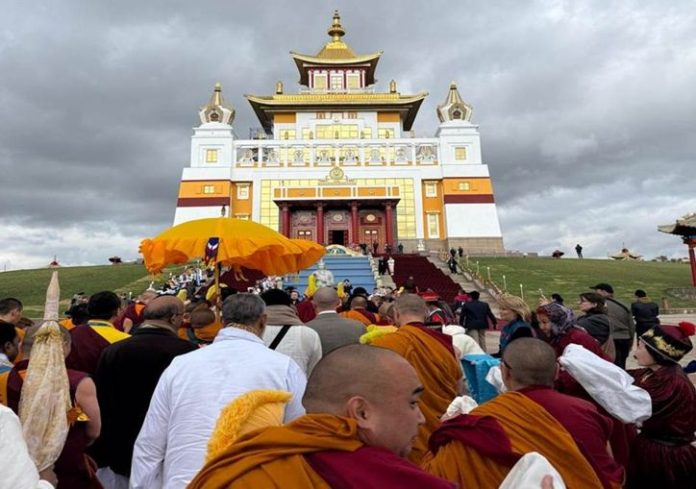The Holy Relics of Sakyamuni Buddha, revered worldwide and designated as a National Treasure of India, were exhibited to the public in the Republic of Kalmykia, Russia — a region with a predominantly Buddhist population.
The week-long exposition, held from 11 to 18 October 2025 at the Central Temple “Golden Abode of Shakyamuni Buddha” in Elista, drew an overwhelming response. Russian media reported that tens of thousands of devotees from across the region paid their respects, describing the event as one of great cultural and spiritual significance. The exposition also offered the Russian public an opportunity to learn more about the rich Buddhist heritage shared with India.
The relics were flown ceremoniously from the National Museum in New Delhi aboard a special Indian Air Force aircraft, accompanied by senior monks and officials, following all religious protocols. The Indian delegation was led by Uttar Pradesh Deputy Chief Minister Keshav Prasad Maurya for the inauguration, while the concluding ceremony and return journey were led by Lieutenant Governor of Jammu and Kashmir Manoj Sinha. The event was organised by India’s Ministry of Culture, in collaboration with the National Museum, the International Buddhist Confederation (IBC), and the Indira Gandhi National Centre for the Arts (IGNCA).
Over 90,000 people visited Elista’s Ganden Sheddup Choikorling Monastery during the exposition. As Europe’s only Buddhist-majority region, Kalmykia’s media described the event as a “homecoming of faith” for the local population, underscoring their enduring spiritual and cultural connection to Buddhism.
This first-of-its-kind event in Russia also celebrated the legacy of the 19th Kushok Bakula Rinpoche, the revered monk and diplomat from Ladakh who was instrumental in reviving Buddhism in Mongolia and Russia’s Buddhist regions — Buryatia, Kalmykia, and Tuva.
The exposition highlighted the shared Buddhist heritage between India and Russia, aiming to strengthen the faith of local devotees and inspire younger generations. Complementary events included special religious services by senior Indian monks, lectures on Buddhist art and archaeology, and an exhibition of paintings by Indian artist Vasudeo Kamath depicting key moments in the Buddha’s life.
In a landmark move to enhance educational and cultural cooperation, Kalmyk State University in Elista signed a Memorandum of Cooperation with India’s Nalanda University. Representing Nalanda, Vice-Chancellor Prof. Sachin Chaturvedi said the collaboration aligns with the university’s ancient legacy as a global hub of learning and intercultural dialogue.
During the visit, the Deputy Chief Minister of Uttar Pradesh presented sets of the Kanjur — 108 Mongolian-language volumes translated from Tibetan — to local monasteries and Kalmyk State University. Produced by the Manuscripts Division of India’s Ministry of Culture, the sets were handed over on behalf of the IBC.
At the concluding ceremony, Manoj Sinha presented permanent exhibitions from the International Buddhist Confederation and the National Museum of India to the Kalmyk Museum in Elista, noting that they would serve as a lasting reminder of Lord Buddha’s universal message and the significance of this historic visit.
The accompanying lecture series attracted scholars, researchers, and the public, sparking vibrant discussions on Buddhist philosophy, archaeology, and art — reinforcing the deep civilisational dialogue between India and the broader Buddhist world.




